Cultural Safety for Aboriginal and Torres Strait Islander Peoples
VerifiedAdded on 2021/02/20
|12
|2039
|85
Report
AI Summary
This report delves into the crucial aspects of cultural safety within Aboriginal and Torres Strait Islander communities. It begins by outlining the impact of historical events, such as the loss of land and government policies, on the current health and wellbeing of these communities. The report then explores the positive effects of reconciliation policies. It further examines how historical events and legislation have shaped current service delivery, including the incorporation of cultural practices and the role of the Racial Discrimination Act. The report also addresses issues influencing relationships, communication, and partnership building, as well as how one's own cultural values may influence service delivery. Additionally, the report provides insights into consulting and communicating to ensure culturally safe services, and evaluates reconciliation action plans and their outcomes, emphasizing strategies for promoting cultural safety practices, including cultural awareness and competence. References are included from various books and journals, providing a comprehensive overview of the topic.
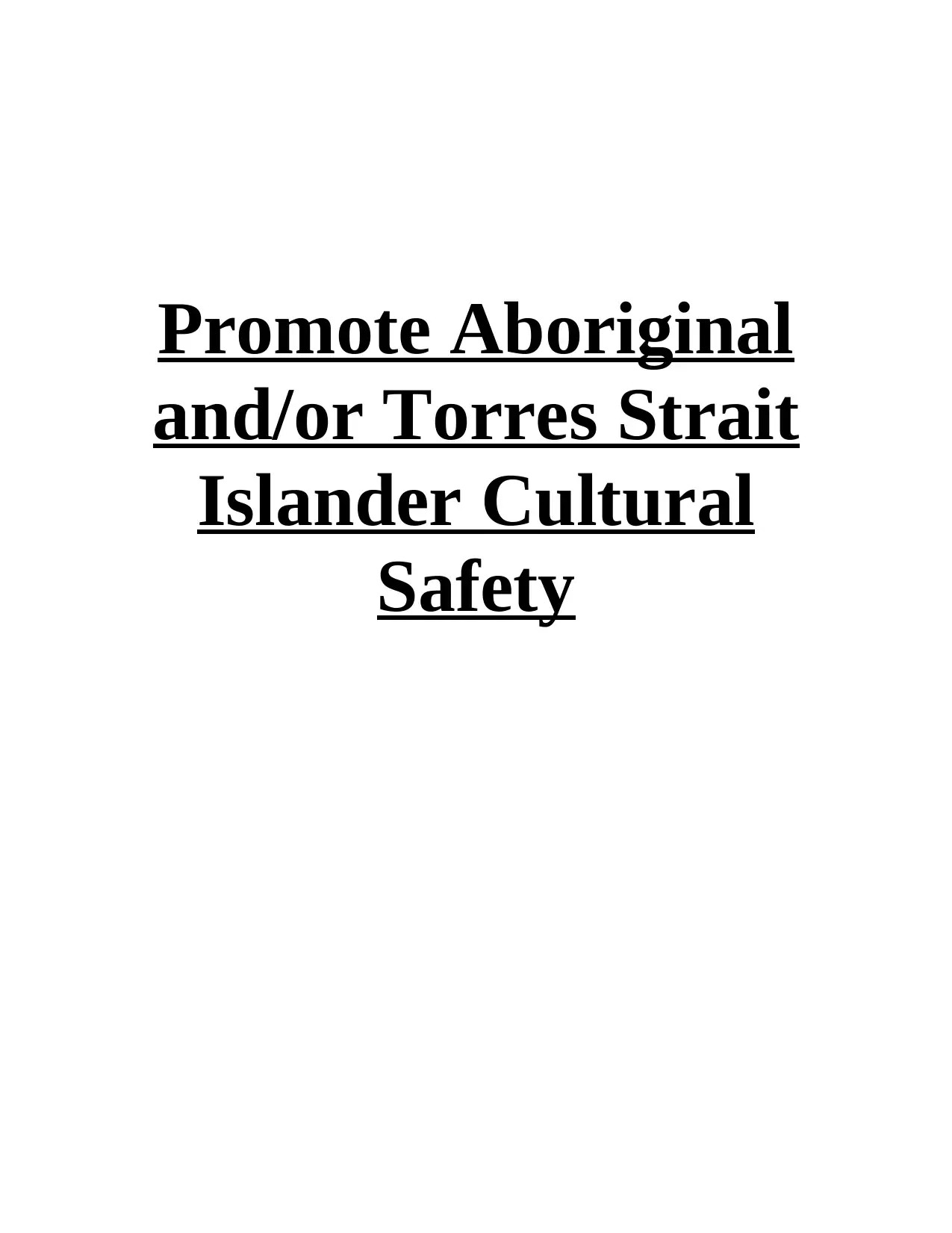
Promote Aboriginal
and/or Torres Strait
Islander Cultural
Safety
and/or Torres Strait
Islander Cultural
Safety
Paraphrase This Document
Need a fresh take? Get an instant paraphrase of this document with our AI Paraphraser
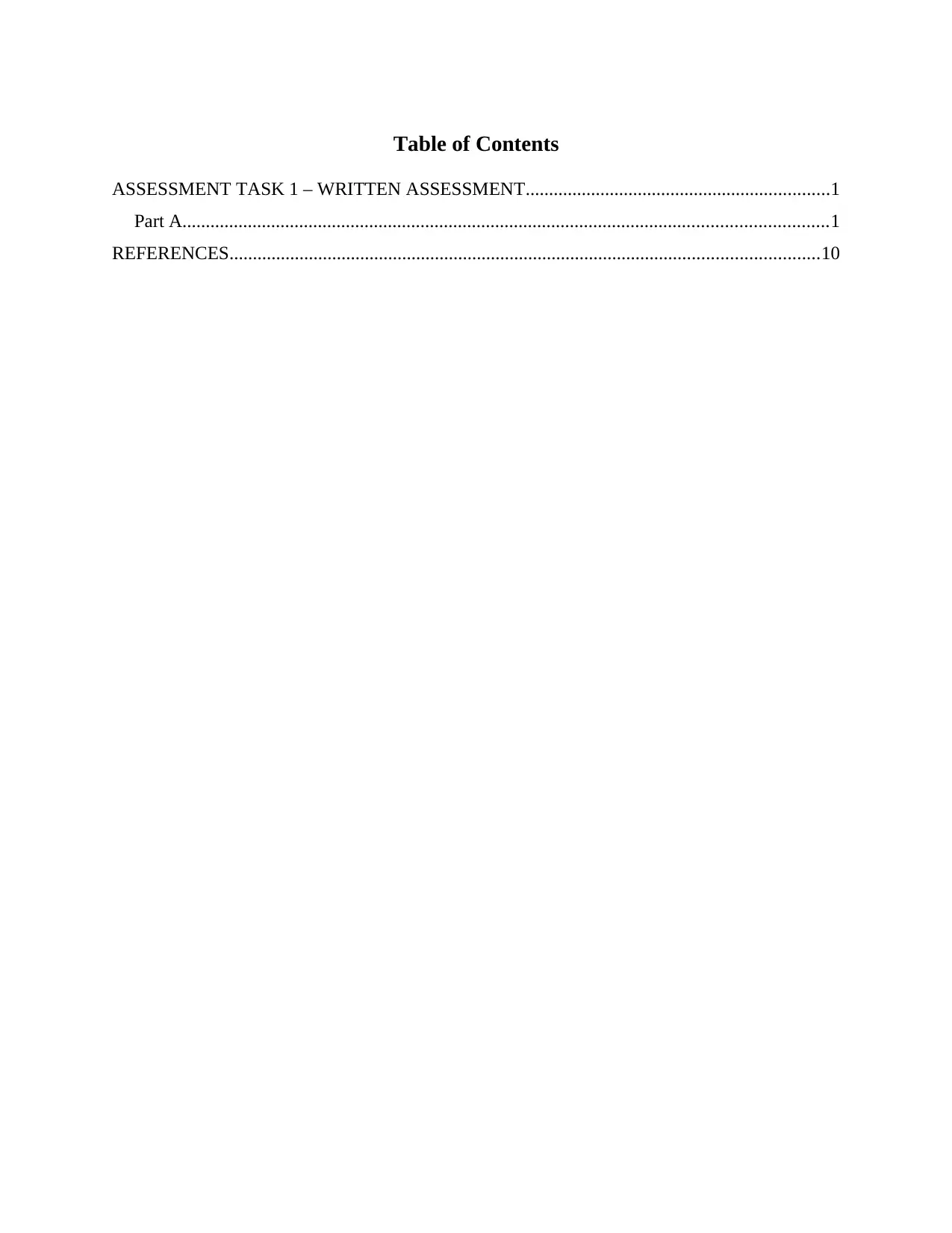
Table of Contents
ASSESSMENT TASK 1 – WRITTEN ASSESSMENT.................................................................1
Part A..........................................................................................................................................1
REFERENCES..............................................................................................................................10
ASSESSMENT TASK 1 – WRITTEN ASSESSMENT.................................................................1
Part A..........................................................................................................................................1
REFERENCES..............................................................................................................................10
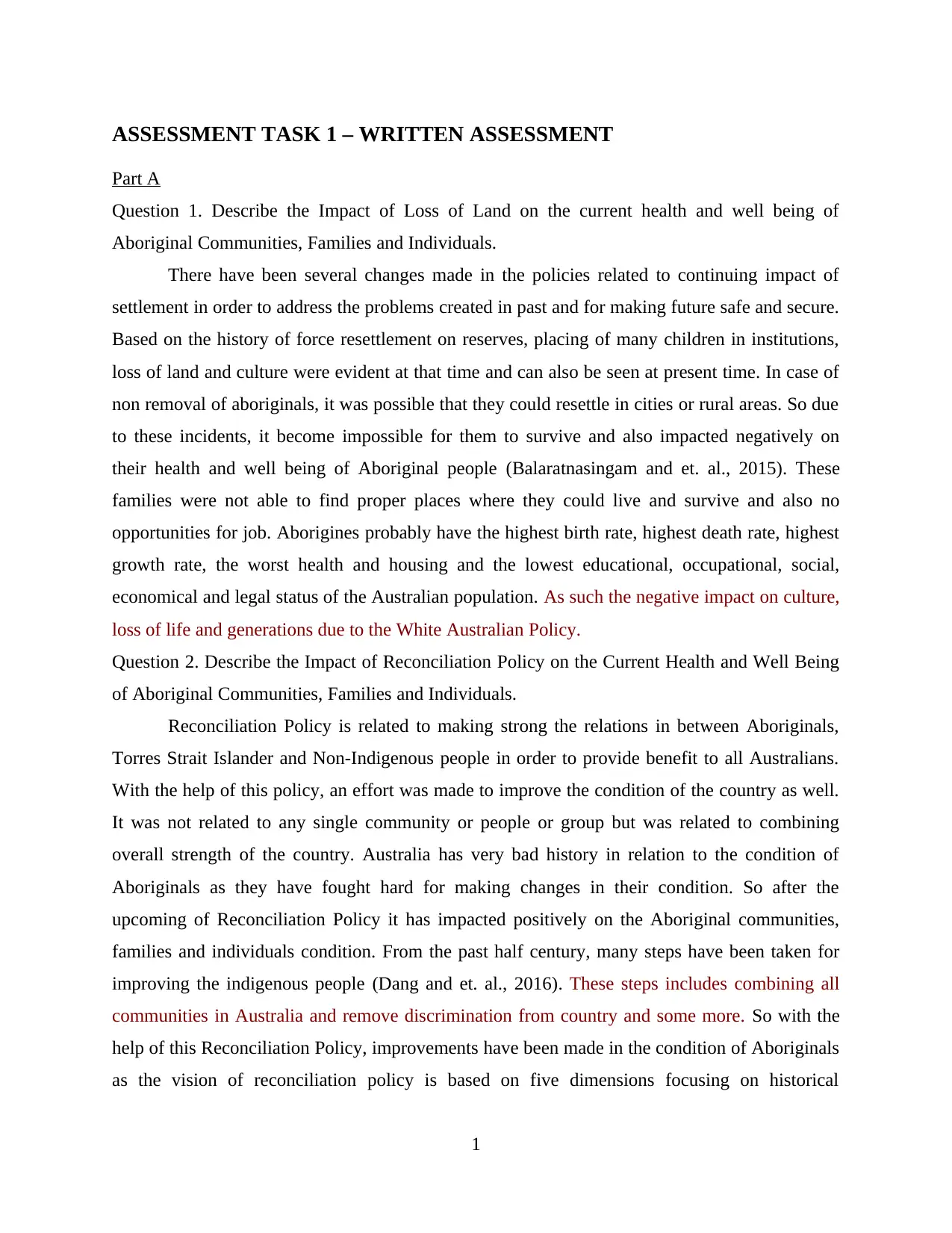
ASSESSMENT TASK 1 – WRITTEN ASSESSMENT
Part A
Question 1. Describe the Impact of Loss of Land on the current health and well being of
Aboriginal Communities, Families and Individuals.
There have been several changes made in the policies related to continuing impact of
settlement in order to address the problems created in past and for making future safe and secure.
Based on the history of force resettlement on reserves, placing of many children in institutions,
loss of land and culture were evident at that time and can also be seen at present time. In case of
non removal of aboriginals, it was possible that they could resettle in cities or rural areas. So due
to these incidents, it become impossible for them to survive and also impacted negatively on
their health and well being of Aboriginal people (Balaratnasingam and et. al., 2015). These
families were not able to find proper places where they could live and survive and also no
opportunities for job. Aborigines probably have the highest birth rate, highest death rate, highest
growth rate, the worst health and housing and the lowest educational, occupational, social,
economical and legal status of the Australian population. As such the negative impact on culture,
loss of life and generations due to the White Australian Policy.
Question 2. Describe the Impact of Reconciliation Policy on the Current Health and Well Being
of Aboriginal Communities, Families and Individuals.
Reconciliation Policy is related to making strong the relations in between Aboriginals,
Torres Strait Islander and Non-Indigenous people in order to provide benefit to all Australians.
With the help of this policy, an effort was made to improve the condition of the country as well.
It was not related to any single community or people or group but was related to combining
overall strength of the country. Australia has very bad history in relation to the condition of
Aboriginals as they have fought hard for making changes in their condition. So after the
upcoming of Reconciliation Policy it has impacted positively on the Aboriginal communities,
families and individuals condition. From the past half century, many steps have been taken for
improving the indigenous people (Dang and et. al., 2016). These steps includes combining all
communities in Australia and remove discrimination from country and some more. So with the
help of this Reconciliation Policy, improvements have been made in the condition of Aboriginals
as the vision of reconciliation policy is based on five dimensions focusing on historical
1
Part A
Question 1. Describe the Impact of Loss of Land on the current health and well being of
Aboriginal Communities, Families and Individuals.
There have been several changes made in the policies related to continuing impact of
settlement in order to address the problems created in past and for making future safe and secure.
Based on the history of force resettlement on reserves, placing of many children in institutions,
loss of land and culture were evident at that time and can also be seen at present time. In case of
non removal of aboriginals, it was possible that they could resettle in cities or rural areas. So due
to these incidents, it become impossible for them to survive and also impacted negatively on
their health and well being of Aboriginal people (Balaratnasingam and et. al., 2015). These
families were not able to find proper places where they could live and survive and also no
opportunities for job. Aborigines probably have the highest birth rate, highest death rate, highest
growth rate, the worst health and housing and the lowest educational, occupational, social,
economical and legal status of the Australian population. As such the negative impact on culture,
loss of life and generations due to the White Australian Policy.
Question 2. Describe the Impact of Reconciliation Policy on the Current Health and Well Being
of Aboriginal Communities, Families and Individuals.
Reconciliation Policy is related to making strong the relations in between Aboriginals,
Torres Strait Islander and Non-Indigenous people in order to provide benefit to all Australians.
With the help of this policy, an effort was made to improve the condition of the country as well.
It was not related to any single community or people or group but was related to combining
overall strength of the country. Australia has very bad history in relation to the condition of
Aboriginals as they have fought hard for making changes in their condition. So after the
upcoming of Reconciliation Policy it has impacted positively on the Aboriginal communities,
families and individuals condition. From the past half century, many steps have been taken for
improving the indigenous people (Dang and et. al., 2016). These steps includes combining all
communities in Australia and remove discrimination from country and some more. So with the
help of this Reconciliation Policy, improvements have been made in the condition of Aboriginals
as the vision of reconciliation policy is based on five dimensions focusing on historical
1
⊘ This is a preview!⊘
Do you want full access?
Subscribe today to unlock all pages.

Trusted by 1+ million students worldwide
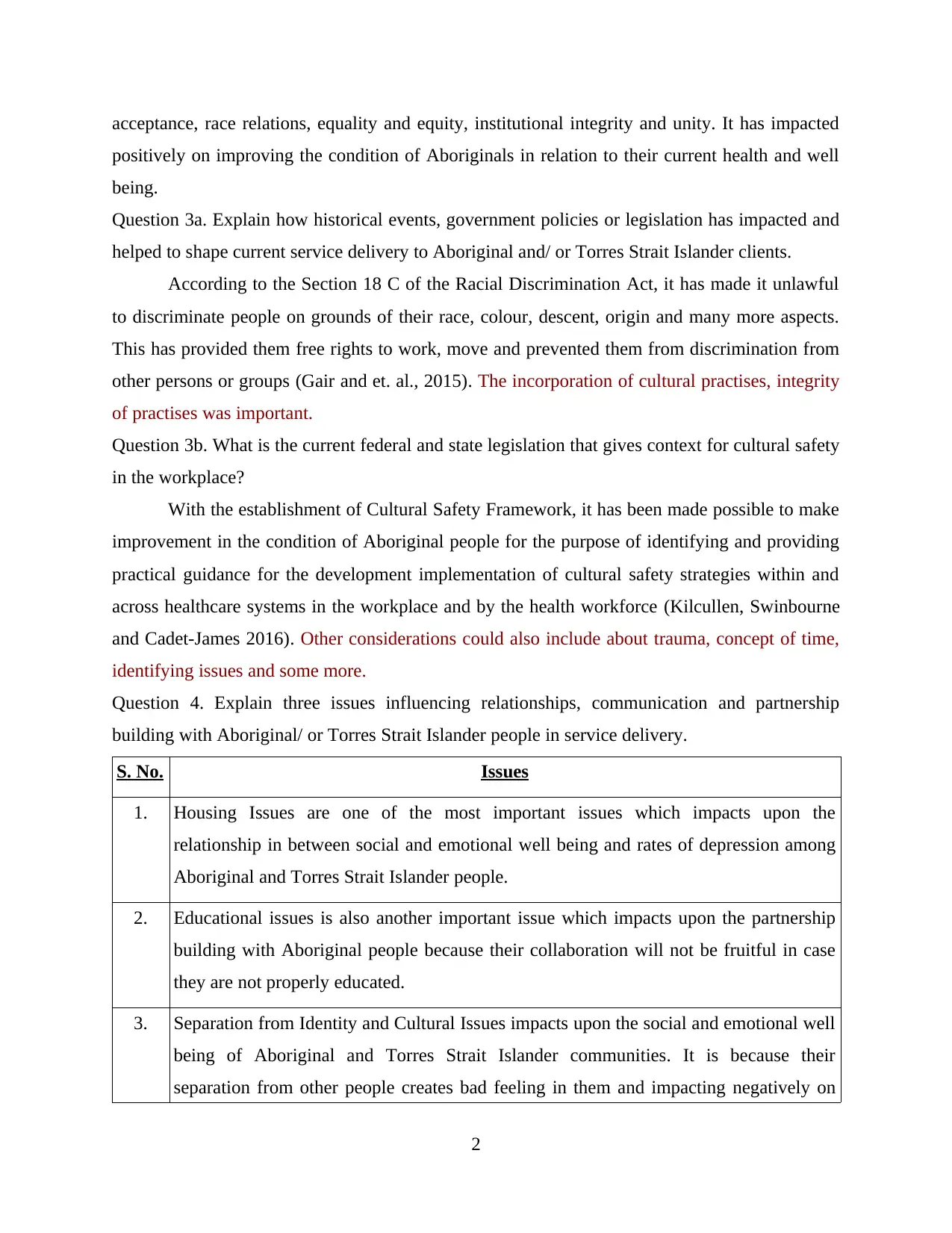
acceptance, race relations, equality and equity, institutional integrity and unity. It has impacted
positively on improving the condition of Aboriginals in relation to their current health and well
being.
Question 3a. Explain how historical events, government policies or legislation has impacted and
helped to shape current service delivery to Aboriginal and/ or Torres Strait Islander clients.
According to the Section 18 C of the Racial Discrimination Act, it has made it unlawful
to discriminate people on grounds of their race, colour, descent, origin and many more aspects.
This has provided them free rights to work, move and prevented them from discrimination from
other persons or groups (Gair and et. al., 2015). The incorporation of cultural practises, integrity
of practises was important.
Question 3b. What is the current federal and state legislation that gives context for cultural safety
in the workplace?
With the establishment of Cultural Safety Framework, it has been made possible to make
improvement in the condition of Aboriginal people for the purpose of identifying and providing
practical guidance for the development implementation of cultural safety strategies within and
across healthcare systems in the workplace and by the health workforce (Kilcullen, Swinbourne
and Cadet‐James 2016). Other considerations could also include about trauma, concept of time,
identifying issues and some more.
Question 4. Explain three issues influencing relationships, communication and partnership
building with Aboriginal/ or Torres Strait Islander people in service delivery.
S. No. Issues
1. Housing Issues are one of the most important issues which impacts upon the
relationship in between social and emotional well being and rates of depression among
Aboriginal and Torres Strait Islander people.
2. Educational issues is also another important issue which impacts upon the partnership
building with Aboriginal people because their collaboration will not be fruitful in case
they are not properly educated.
3. Separation from Identity and Cultural Issues impacts upon the social and emotional well
being of Aboriginal and Torres Strait Islander communities. It is because their
separation from other people creates bad feeling in them and impacting negatively on
2
positively on improving the condition of Aboriginals in relation to their current health and well
being.
Question 3a. Explain how historical events, government policies or legislation has impacted and
helped to shape current service delivery to Aboriginal and/ or Torres Strait Islander clients.
According to the Section 18 C of the Racial Discrimination Act, it has made it unlawful
to discriminate people on grounds of their race, colour, descent, origin and many more aspects.
This has provided them free rights to work, move and prevented them from discrimination from
other persons or groups (Gair and et. al., 2015). The incorporation of cultural practises, integrity
of practises was important.
Question 3b. What is the current federal and state legislation that gives context for cultural safety
in the workplace?
With the establishment of Cultural Safety Framework, it has been made possible to make
improvement in the condition of Aboriginal people for the purpose of identifying and providing
practical guidance for the development implementation of cultural safety strategies within and
across healthcare systems in the workplace and by the health workforce (Kilcullen, Swinbourne
and Cadet‐James 2016). Other considerations could also include about trauma, concept of time,
identifying issues and some more.
Question 4. Explain three issues influencing relationships, communication and partnership
building with Aboriginal/ or Torres Strait Islander people in service delivery.
S. No. Issues
1. Housing Issues are one of the most important issues which impacts upon the
relationship in between social and emotional well being and rates of depression among
Aboriginal and Torres Strait Islander people.
2. Educational issues is also another important issue which impacts upon the partnership
building with Aboriginal people because their collaboration will not be fruitful in case
they are not properly educated.
3. Separation from Identity and Cultural Issues impacts upon the social and emotional well
being of Aboriginal and Torres Strait Islander communities. It is because their
separation from other people creates bad feeling in them and impacting negatively on
2
Paraphrase This Document
Need a fresh take? Get an instant paraphrase of this document with our AI Paraphraser
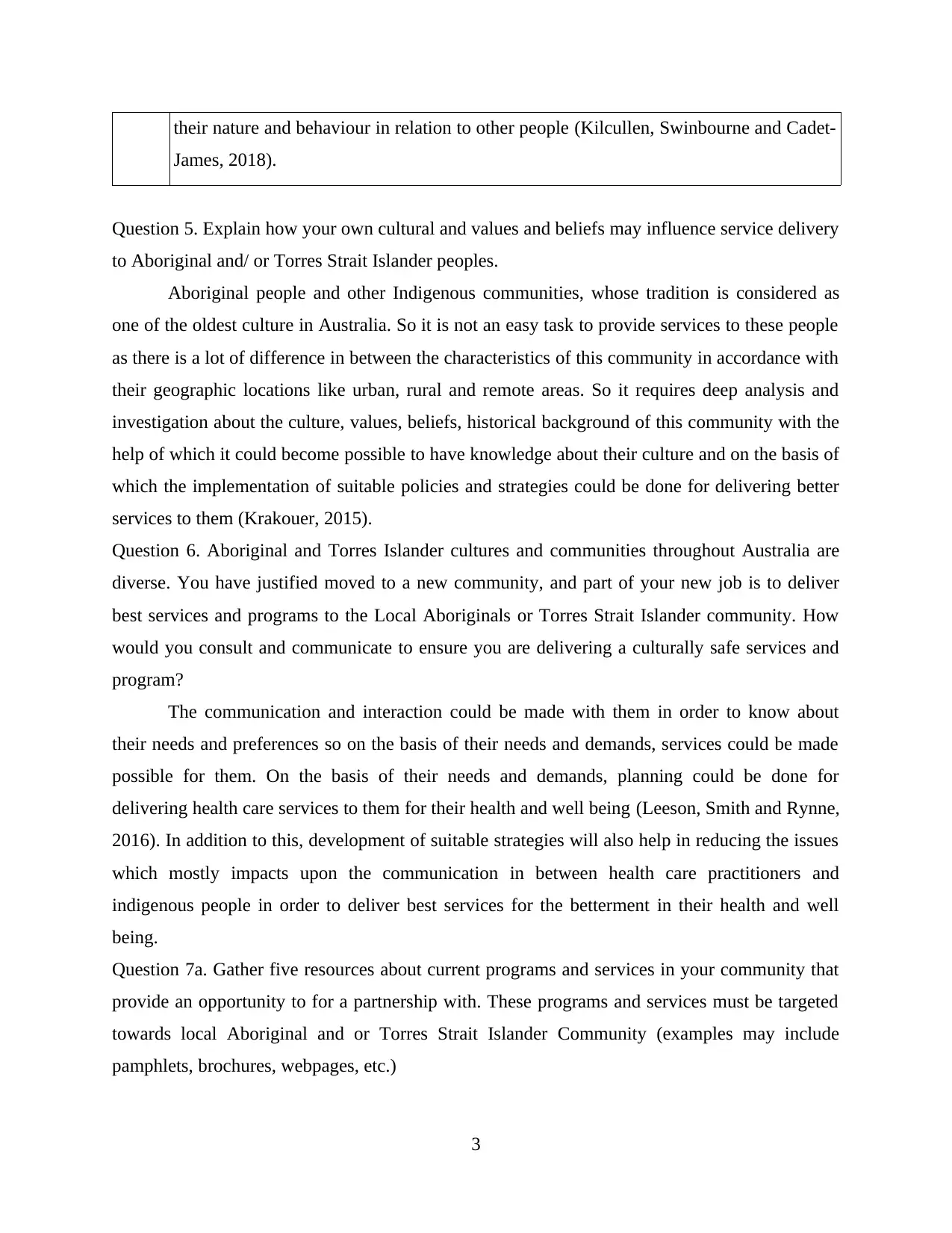
their nature and behaviour in relation to other people (Kilcullen, Swinbourne and Cadet‐
James, 2018).
Question 5. Explain how your own cultural and values and beliefs may influence service delivery
to Aboriginal and/ or Torres Strait Islander peoples.
Aboriginal people and other Indigenous communities, whose tradition is considered as
one of the oldest culture in Australia. So it is not an easy task to provide services to these people
as there is a lot of difference in between the characteristics of this community in accordance with
their geographic locations like urban, rural and remote areas. So it requires deep analysis and
investigation about the culture, values, beliefs, historical background of this community with the
help of which it could become possible to have knowledge about their culture and on the basis of
which the implementation of suitable policies and strategies could be done for delivering better
services to them (Krakouer, 2015).
Question 6. Aboriginal and Torres Islander cultures and communities throughout Australia are
diverse. You have justified moved to a new community, and part of your new job is to deliver
best services and programs to the Local Aboriginals or Torres Strait Islander community. How
would you consult and communicate to ensure you are delivering a culturally safe services and
program?
The communication and interaction could be made with them in order to know about
their needs and preferences so on the basis of their needs and demands, services could be made
possible for them. On the basis of their needs and demands, planning could be done for
delivering health care services to them for their health and well being (Leeson, Smith and Rynne,
2016). In addition to this, development of suitable strategies will also help in reducing the issues
which mostly impacts upon the communication in between health care practitioners and
indigenous people in order to deliver best services for the betterment in their health and well
being.
Question 7a. Gather five resources about current programs and services in your community that
provide an opportunity to for a partnership with. These programs and services must be targeted
towards local Aboriginal and or Torres Strait Islander Community (examples may include
pamphlets, brochures, webpages, etc.)
3
James, 2018).
Question 5. Explain how your own cultural and values and beliefs may influence service delivery
to Aboriginal and/ or Torres Strait Islander peoples.
Aboriginal people and other Indigenous communities, whose tradition is considered as
one of the oldest culture in Australia. So it is not an easy task to provide services to these people
as there is a lot of difference in between the characteristics of this community in accordance with
their geographic locations like urban, rural and remote areas. So it requires deep analysis and
investigation about the culture, values, beliefs, historical background of this community with the
help of which it could become possible to have knowledge about their culture and on the basis of
which the implementation of suitable policies and strategies could be done for delivering better
services to them (Krakouer, 2015).
Question 6. Aboriginal and Torres Islander cultures and communities throughout Australia are
diverse. You have justified moved to a new community, and part of your new job is to deliver
best services and programs to the Local Aboriginals or Torres Strait Islander community. How
would you consult and communicate to ensure you are delivering a culturally safe services and
program?
The communication and interaction could be made with them in order to know about
their needs and preferences so on the basis of their needs and demands, services could be made
possible for them. On the basis of their needs and demands, planning could be done for
delivering health care services to them for their health and well being (Leeson, Smith and Rynne,
2016). In addition to this, development of suitable strategies will also help in reducing the issues
which mostly impacts upon the communication in between health care practitioners and
indigenous people in order to deliver best services for the betterment in their health and well
being.
Question 7a. Gather five resources about current programs and services in your community that
provide an opportunity to for a partnership with. These programs and services must be targeted
towards local Aboriginal and or Torres Strait Islander Community (examples may include
pamphlets, brochures, webpages, etc.)
3
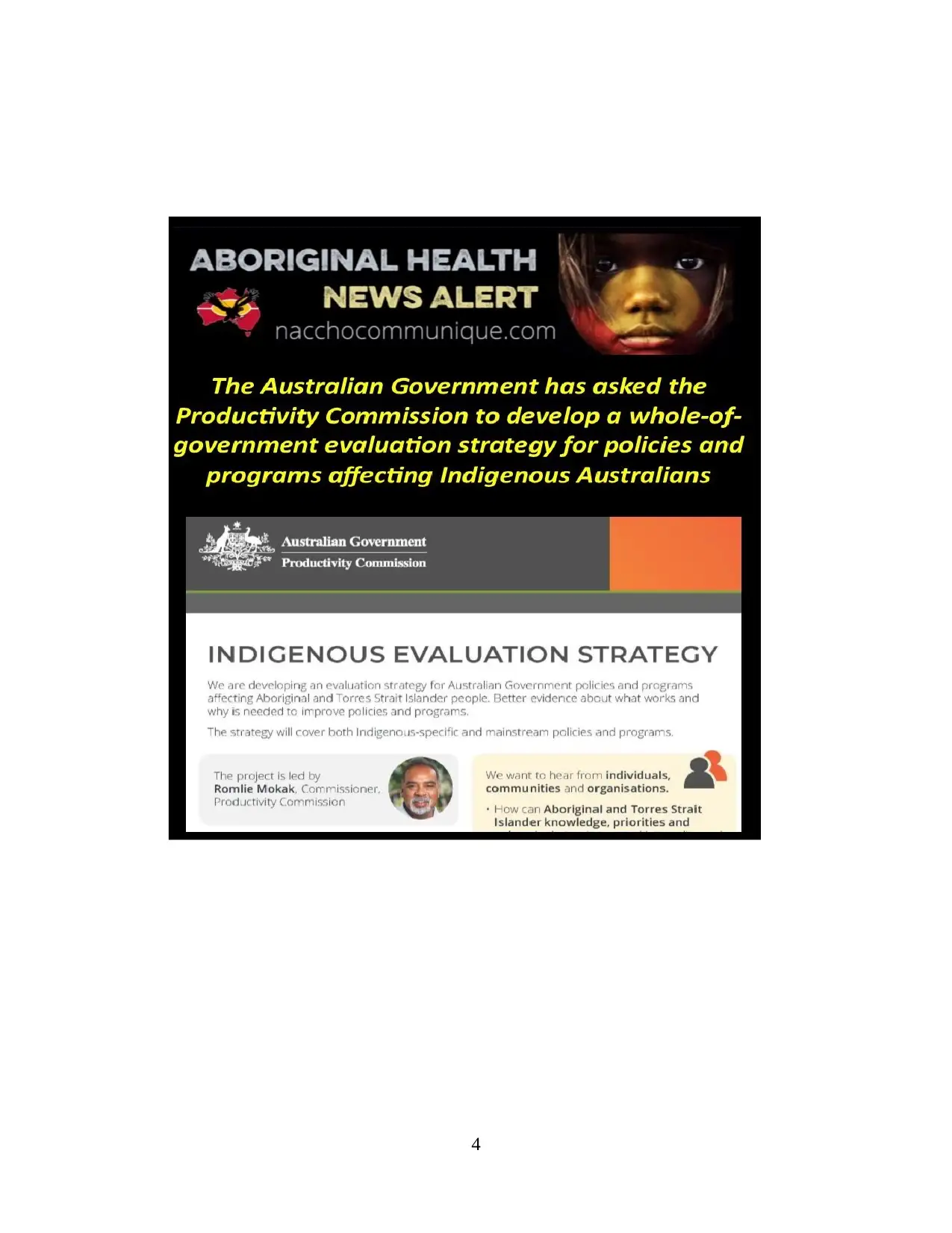
4
⊘ This is a preview!⊘
Do you want full access?
Subscribe today to unlock all pages.

Trusted by 1+ million students worldwide
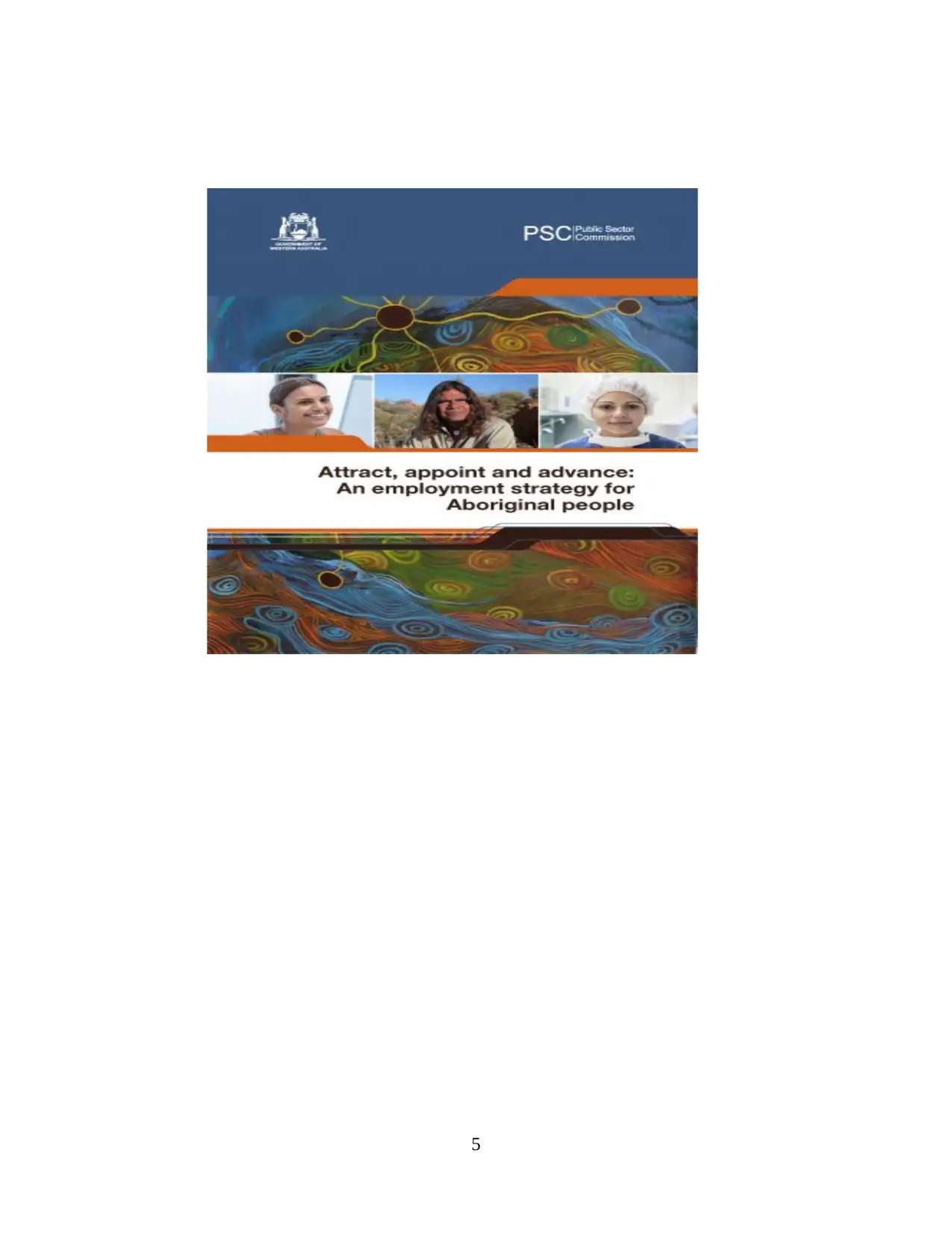
5
Paraphrase This Document
Need a fresh take? Get an instant paraphrase of this document with our AI Paraphraser
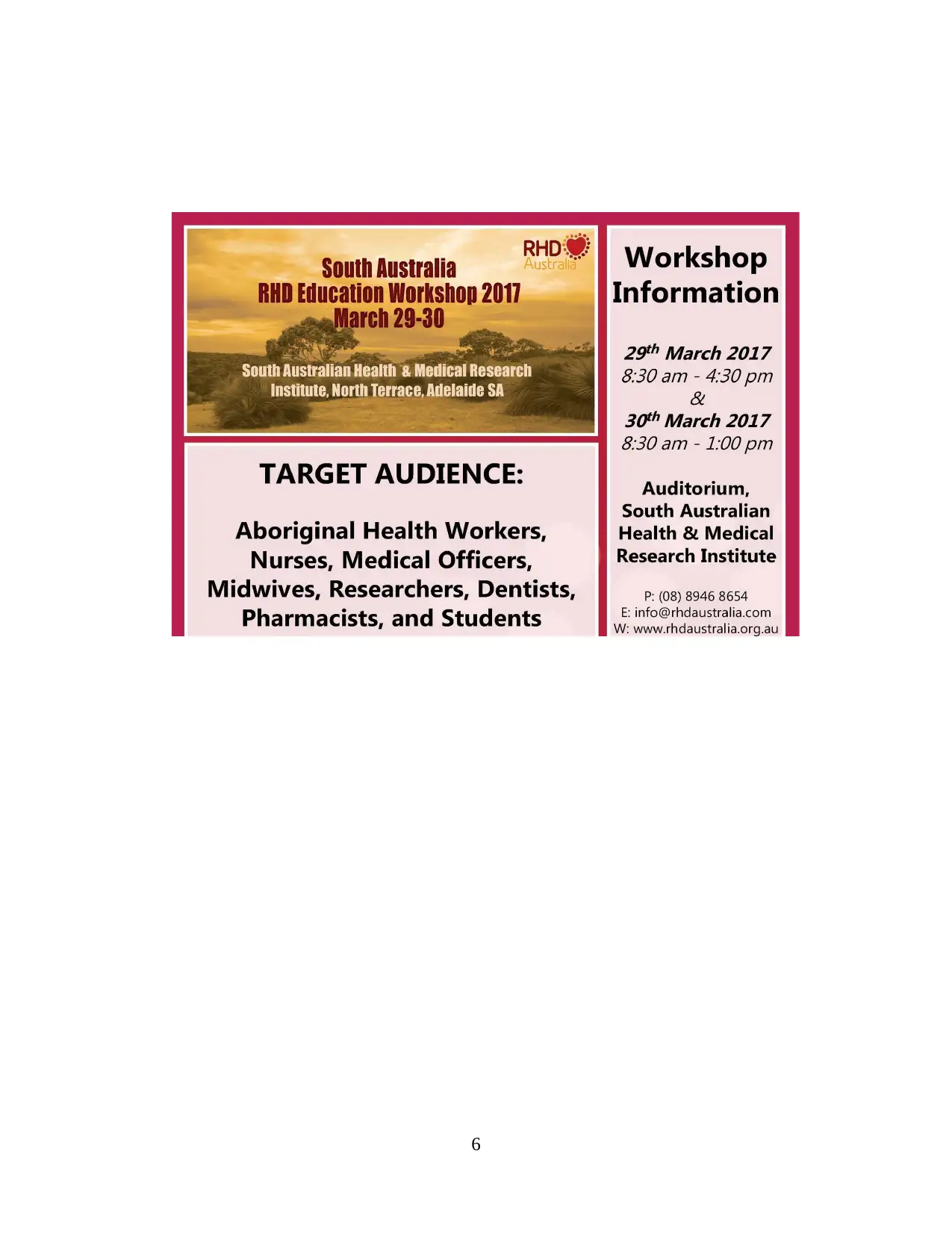
6
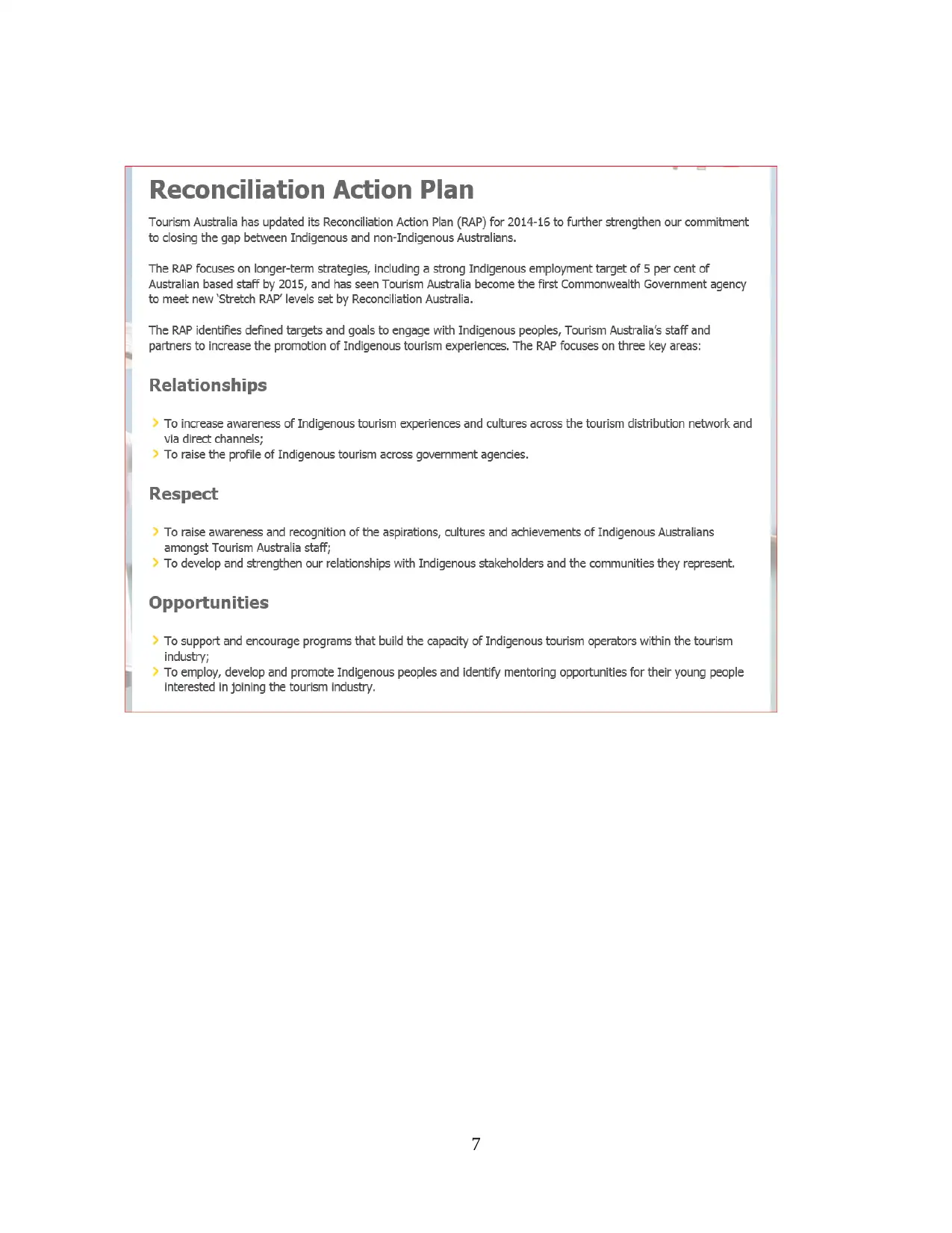
7
⊘ This is a preview!⊘
Do you want full access?
Subscribe today to unlock all pages.

Trusted by 1+ million students worldwide
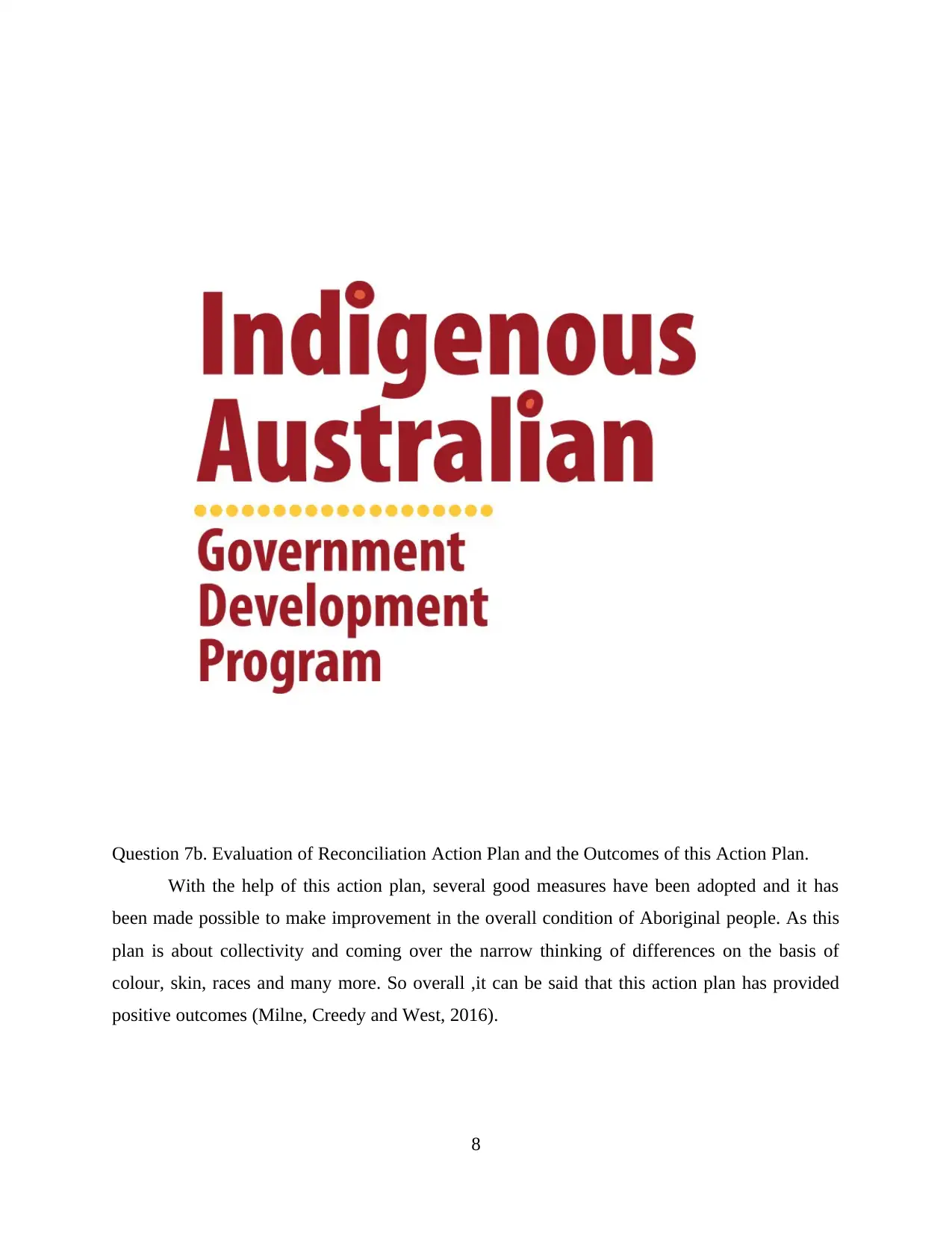
Question 7b. Evaluation of Reconciliation Action Plan and the Outcomes of this Action Plan.
With the help of this action plan, several good measures have been adopted and it has
been made possible to make improvement in the overall condition of Aboriginal people. As this
plan is about collectivity and coming over the narrow thinking of differences on the basis of
colour, skin, races and many more. So overall ,it can be said that this action plan has provided
positive outcomes (Milne, Creedy and West, 2016).
8
With the help of this action plan, several good measures have been adopted and it has
been made possible to make improvement in the overall condition of Aboriginal people. As this
plan is about collectivity and coming over the narrow thinking of differences on the basis of
colour, skin, races and many more. So overall ,it can be said that this action plan has provided
positive outcomes (Milne, Creedy and West, 2016).
8
Paraphrase This Document
Need a fresh take? Get an instant paraphrase of this document with our AI Paraphraser
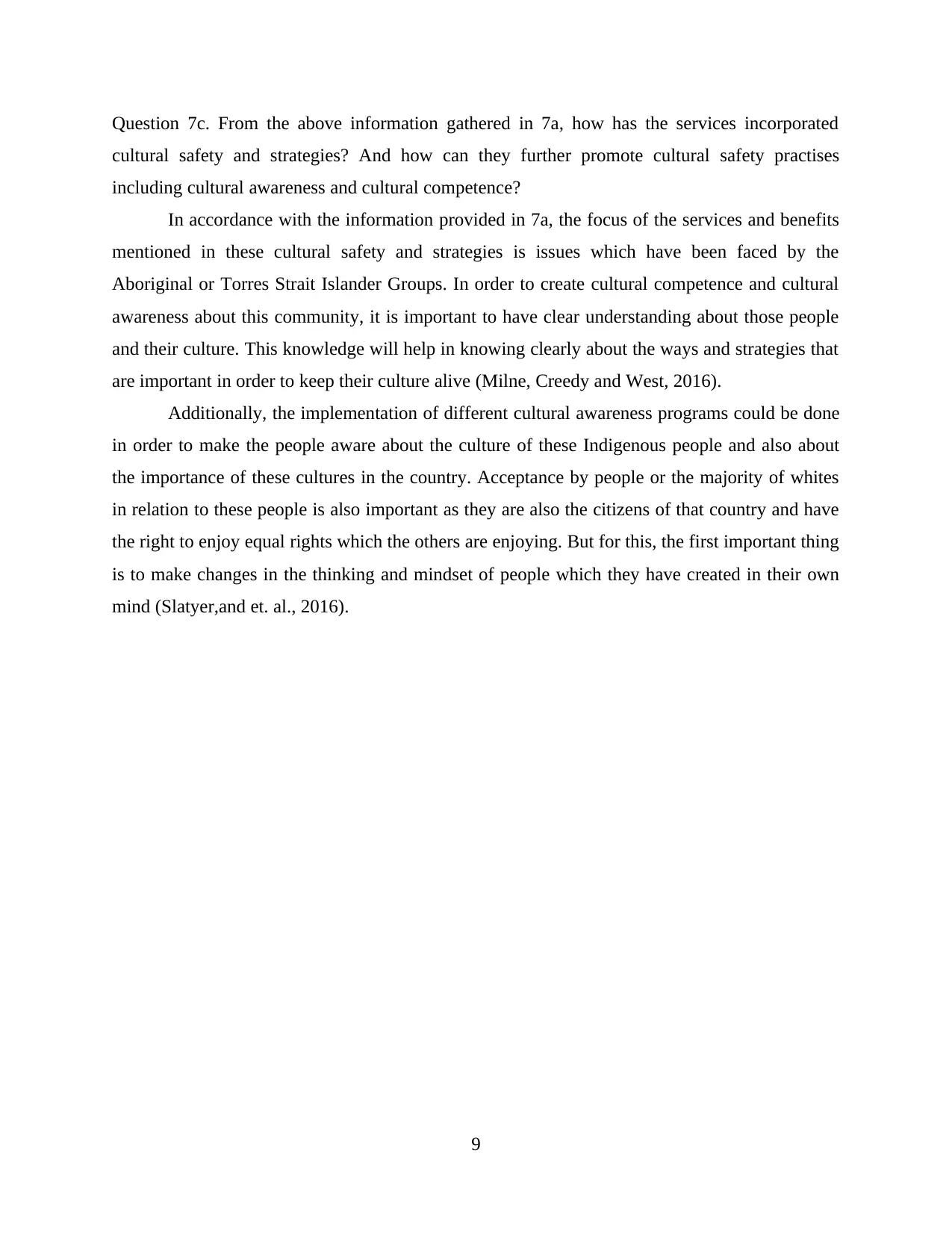
Question 7c. From the above information gathered in 7a, how has the services incorporated
cultural safety and strategies? And how can they further promote cultural safety practises
including cultural awareness and cultural competence?
In accordance with the information provided in 7a, the focus of the services and benefits
mentioned in these cultural safety and strategies is issues which have been faced by the
Aboriginal or Torres Strait Islander Groups. In order to create cultural competence and cultural
awareness about this community, it is important to have clear understanding about those people
and their culture. This knowledge will help in knowing clearly about the ways and strategies that
are important in order to keep their culture alive (Milne, Creedy and West, 2016).
Additionally, the implementation of different cultural awareness programs could be done
in order to make the people aware about the culture of these Indigenous people and also about
the importance of these cultures in the country. Acceptance by people or the majority of whites
in relation to these people is also important as they are also the citizens of that country and have
the right to enjoy equal rights which the others are enjoying. But for this, the first important thing
is to make changes in the thinking and mindset of people which they have created in their own
mind (Slatyer,and et. al., 2016).
9
cultural safety and strategies? And how can they further promote cultural safety practises
including cultural awareness and cultural competence?
In accordance with the information provided in 7a, the focus of the services and benefits
mentioned in these cultural safety and strategies is issues which have been faced by the
Aboriginal or Torres Strait Islander Groups. In order to create cultural competence and cultural
awareness about this community, it is important to have clear understanding about those people
and their culture. This knowledge will help in knowing clearly about the ways and strategies that
are important in order to keep their culture alive (Milne, Creedy and West, 2016).
Additionally, the implementation of different cultural awareness programs could be done
in order to make the people aware about the culture of these Indigenous people and also about
the importance of these cultures in the country. Acceptance by people or the majority of whites
in relation to these people is also important as they are also the citizens of that country and have
the right to enjoy equal rights which the others are enjoying. But for this, the first important thing
is to make changes in the thinking and mindset of people which they have created in their own
mind (Slatyer,and et. al., 2016).
9
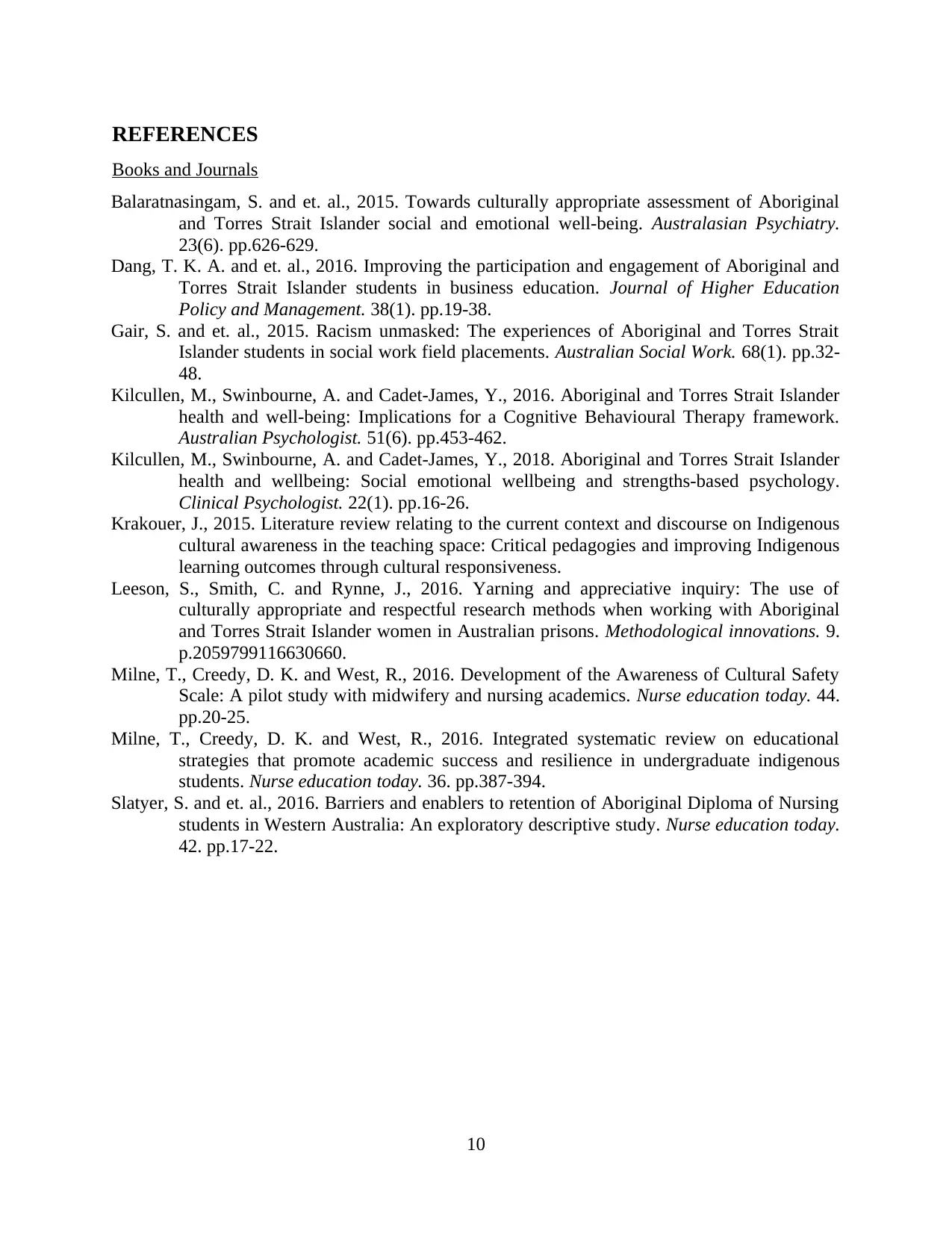
REFERENCES
Books and Journals
Balaratnasingam, S. and et. al., 2015. Towards culturally appropriate assessment of Aboriginal
and Torres Strait Islander social and emotional well-being. Australasian Psychiatry.
23(6). pp.626-629.
Dang, T. K. A. and et. al., 2016. Improving the participation and engagement of Aboriginal and
Torres Strait Islander students in business education. Journal of Higher Education
Policy and Management. 38(1). pp.19-38.
Gair, S. and et. al., 2015. Racism unmasked: The experiences of Aboriginal and Torres Strait
Islander students in social work field placements. Australian Social Work. 68(1). pp.32-
48.
Kilcullen, M., Swinbourne, A. and Cadet‐James, Y., 2016. Aboriginal and Torres Strait Islander
health and well‐being: Implications for a Cognitive Behavioural Therapy framework.
Australian Psychologist. 51(6). pp.453-462.
Kilcullen, M., Swinbourne, A. and Cadet‐James, Y., 2018. Aboriginal and Torres Strait Islander
health and wellbeing: Social emotional wellbeing and strengths‐based psychology.
Clinical Psychologist. 22(1). pp.16-26.
Krakouer, J., 2015. Literature review relating to the current context and discourse on Indigenous
cultural awareness in the teaching space: Critical pedagogies and improving Indigenous
learning outcomes through cultural responsiveness.
Leeson, S., Smith, C. and Rynne, J., 2016. Yarning and appreciative inquiry: The use of
culturally appropriate and respectful research methods when working with Aboriginal
and Torres Strait Islander women in Australian prisons. Methodological innovations. 9.
p.2059799116630660.
Milne, T., Creedy, D. K. and West, R., 2016. Development of the Awareness of Cultural Safety
Scale: A pilot study with midwifery and nursing academics. Nurse education today. 44.
pp.20-25.
Milne, T., Creedy, D. K. and West, R., 2016. Integrated systematic review on educational
strategies that promote academic success and resilience in undergraduate indigenous
students. Nurse education today. 36. pp.387-394.
Slatyer, S. and et. al., 2016. Barriers and enablers to retention of Aboriginal Diploma of Nursing
students in Western Australia: An exploratory descriptive study. Nurse education today.
42. pp.17-22.
10
Books and Journals
Balaratnasingam, S. and et. al., 2015. Towards culturally appropriate assessment of Aboriginal
and Torres Strait Islander social and emotional well-being. Australasian Psychiatry.
23(6). pp.626-629.
Dang, T. K. A. and et. al., 2016. Improving the participation and engagement of Aboriginal and
Torres Strait Islander students in business education. Journal of Higher Education
Policy and Management. 38(1). pp.19-38.
Gair, S. and et. al., 2015. Racism unmasked: The experiences of Aboriginal and Torres Strait
Islander students in social work field placements. Australian Social Work. 68(1). pp.32-
48.
Kilcullen, M., Swinbourne, A. and Cadet‐James, Y., 2016. Aboriginal and Torres Strait Islander
health and well‐being: Implications for a Cognitive Behavioural Therapy framework.
Australian Psychologist. 51(6). pp.453-462.
Kilcullen, M., Swinbourne, A. and Cadet‐James, Y., 2018. Aboriginal and Torres Strait Islander
health and wellbeing: Social emotional wellbeing and strengths‐based psychology.
Clinical Psychologist. 22(1). pp.16-26.
Krakouer, J., 2015. Literature review relating to the current context and discourse on Indigenous
cultural awareness in the teaching space: Critical pedagogies and improving Indigenous
learning outcomes through cultural responsiveness.
Leeson, S., Smith, C. and Rynne, J., 2016. Yarning and appreciative inquiry: The use of
culturally appropriate and respectful research methods when working with Aboriginal
and Torres Strait Islander women in Australian prisons. Methodological innovations. 9.
p.2059799116630660.
Milne, T., Creedy, D. K. and West, R., 2016. Development of the Awareness of Cultural Safety
Scale: A pilot study with midwifery and nursing academics. Nurse education today. 44.
pp.20-25.
Milne, T., Creedy, D. K. and West, R., 2016. Integrated systematic review on educational
strategies that promote academic success and resilience in undergraduate indigenous
students. Nurse education today. 36. pp.387-394.
Slatyer, S. and et. al., 2016. Barriers and enablers to retention of Aboriginal Diploma of Nursing
students in Western Australia: An exploratory descriptive study. Nurse education today.
42. pp.17-22.
10
⊘ This is a preview!⊘
Do you want full access?
Subscribe today to unlock all pages.

Trusted by 1+ million students worldwide
1 out of 12
Related Documents
Your All-in-One AI-Powered Toolkit for Academic Success.
+13062052269
info@desklib.com
Available 24*7 on WhatsApp / Email
![[object Object]](/_next/static/media/star-bottom.7253800d.svg)
Unlock your academic potential
Copyright © 2020–2025 A2Z Services. All Rights Reserved. Developed and managed by ZUCOL.





